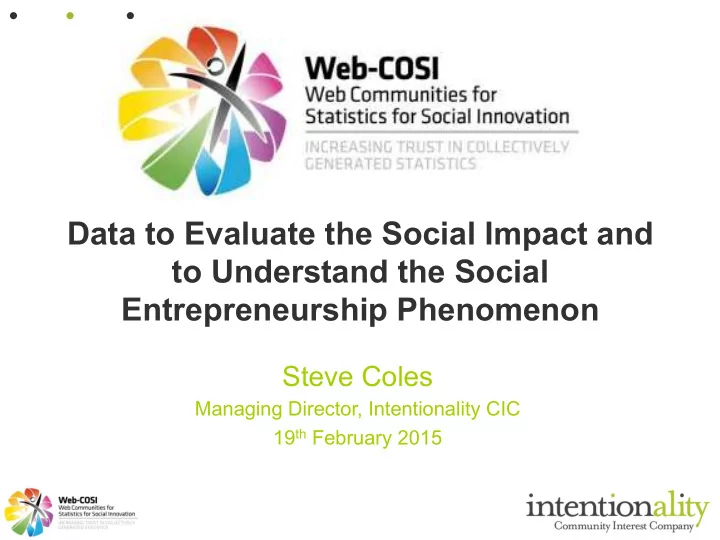

Data to Evaluate the Social Impact and to Understand the Social Entrepreneurship Phenomenon Steve Coles Managing Director, Intentionality CIC 19 th February 2015
Introduction and Contents • How do social enterprises go about measuring impact? – Three complementary elements – Six different approaches – The ‘Building Blocks’ of impact measurement • How we go approach impact measurement – Well-being led approach • Why do social entrepreneurs do impact measurement? • Creating new methods, developing existing methods: – Observed principles – Future focus
How Do Social Enterprises Go About Measuring Impact?
How Do Social Enterprises Go About Measuring Impact? Outputs, Outcomes, Impacts Environmental Outcome-based Impact (PbR) Financial Best Practice Valuation in Reporting (SROI / CBA) Well-being Led
How Do Social Enterprises Go About Measuring Impact? Adapted from: Measuring Social Value, Claudia Wood and Daniel Leighton, Demos, www.demos.co.uk, 2010
How Do Social Enterprises Go About Measuring Impact? Outputs, Outcomes, Impacts Adapted from: Measuring Social Value, Claudia Wood and Daniel Leighton, Demos, www.demos.co.uk, 2010
How Do Social Enterprises Go About Measuring Impact? Outcomes- Based (PbR) Adapted from: Measuring Social Value, Claudia Wood and Daniel Leighton, Demos, www.demos.co.uk, 2010
How Do Social Enterprises Go About Measuring Impact? Financial Valuation Adapted from: Measuring Social Value, Claudia Wood and Daniel Leighton, Demos, www.demos.co.uk, 2010
How Do Social Enterprises Go About Measuring Impact? Well-Being Led Adapted from: Measuring Social Value, Claudia Wood and Daniel Leighton, Demos, www.demos.co.uk, 2010
How We Approach Impact Measurement: Well-Being “Wellbeing is a positive physical, social and mental state; it is not just the absence of pain, discomfort and incapacity. It arises not only from the action of individuals, but from a host of collective goods and relationships with other people. It requires that basic needs are met, that individuals have a sense of purpose , and that they feel able to achieve important personal goals and participate in society . It is enhanced by conditions that include supportive personal relationships , involvement in empowered communities , good health , financial security , rewarding employment , and a healthy and attractive environment ...” UK Government’s Whitehall Wellbeing Working Group, 2006
How We Approach Impact Measurement: Well-Being ‘The ONS Four’ Included in the Office for National Statistics (ONS) Integrated Household Survey: • Overall, how satisfied are you with your life nowadays? • Overall, how happy did you feel yesterday? • Overall, how anxious did you feel yesterday? • Overall, to what extent do you feel that the things you do in life are worthwhile? Each question is answered on a 0-10 scale, where 0 is ‘not at all’ and 10 is ‘completely’.
Why Do Social Entrepreneurs Do Impact Measurement? To enhance To win one-to-one contracts? To target an service (Social intervention provision Value Act) to an area of most need For internal / external reporting To attract investment / To drive funding learning and improvement
The Importance of Public Data Office for National Statistics (UK) – ‘Wheel of Well-Being’ http://bit.ly/16WR4Ts
Creating New Methods, Developing Existing Methods … Observed Principles • Start with aims and objectives – Echo the language • Think about stakeholders (try to identify 15) • Make and keep it simple • Align it with existing rhythms and processes • Create rewards and rituals to celebrate positive impact • Don’t reinvent the wheel (use existing measures) • ‘Begin with the end in mind’ (think about your impact report and align it with best practice)
Creating New Methods, Developing Existing Methods … Future Focus • The role of existing and active public/government datasets is essential as most social enterprises cannot (should not?) use or access control groups • The role of cross-cutting measures is essential to identify a common understanding of impact and to base that on what matters most to people and communities. That’s where well-being measures and data come in. • The role of technology is essential in allowing impact measurement to be understandable, intuitive, unintrusive, simple, quick, safe, interesting … • And, what haven’t we thought of yet?
Many Thanks Steve Coles Intentionality CIC Mob: +44 (0)7791 868597 Web: www.intentionality.co.uk Email: steve@intentionality.co.uk Twitter: steve_coles Twitter: Intentionality_
Recommend
More recommend